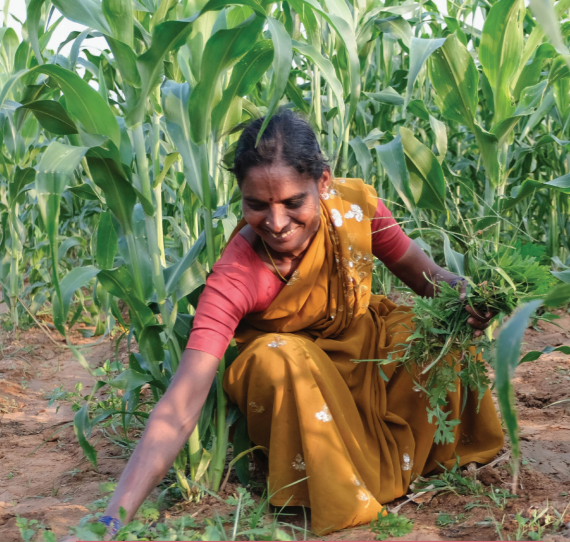Article /
Mainstreaming Gender in Climate Change in India

Introduction
The risks of climate change are differentiated with varying impacts on different groups, sections and communities. This depends on socio-economic and development context, access to resources & information and exposure to climate hazards. It is therefore crucial that adaptation efforts integrate gender issues at all levels, encourage participation of women along with men in the planning and implementation process to address gender differentiated risk and thus ensure greater success of climate actions.
Under the Indo-German Environment Programme in Rural Areas (IGEP-RA) project, the Climate Change Adaptation in Rural Areas of India (CCA-RAI) project aims at integrating climate adaptation measures into the national and state development planning processes. CCA-RAI supports upscaling of successful technical and financial adaptation approaches using instruments such as capacity development, demonstration projects, technical support for accessing national and international climate finance and knowledge management.
The CCA-RAI project recognized the need to undertake “gender analysis”. The aim of such an analysis is to assess and better understand the extent of gender related topics with a view to plan and integrate measures to mainstream gender aspects into CCA-RAI activities.
This report* describes how gender has been mainstreamed in the CCA-RAI project through a gender analysis and the implementation of a gender strategy.
*Download the full report from the right-hand column and see the links below for further reading.
Methods and Tools
As a first step, the following categorization was applied in the analysis to understand the level of gender component in climate activities:

Building on the climate risk concept as mentioned in the Fifth Assessment Report of the Intergovernmental Panel on Climate Change (IPCC AR5), the following figure helps us in identifying entry points for addressing climate change-related gender inequalities:

The methodology for conducting gender analysis comprised of desk study (primary and secondary literature, including India’s national and sub-national climate change and gender related strategies and policies) and partner interactions. In addition, existing and past activities of CCA-RAI such as training modules, demonstration projects as well as design of the projects developed for funding through National Adaptation Fund on Climate Change (NAFCC) were reviewed from the gender perspective.
Key outcomes
1. Developing a gender strategy
The CCA RAI monitoring & evaluation’s already existing objective and output indicators were screened through a gender lens. Accordingly gender strategy was developed which is presented in Table 2 below. Following are the project level indicators and their corresponding targets.

2. Implementation of gender strategy
At the local level, clear evidence exists that, women’s participation has substantial benefits for a project’s outcome and sustainability. Considering this, following steps were undertaken while designing and implementing local level demonstration projects:
- Using gender-sensitive vulnerability and risk assessments as a starting point;
- Conducting gender-balanced and gender-sensitive consultations;
- Plan for gender-specific benefits considering gender-related impacts and risks;
- Develop gender-sensitive results frameworks.
- Encourage active participation of women in consultations
- Engage women as agents of change/multipliers to help increase their influence.
- Sensitize communities for gender-specific climate change impacts.
A dedicated training programme on “Gender mainstreaming in climate change interventions” have been conducted in each of the project partner state to understand the challenges of women and children in procuring resources and in designing gender friendly projects. The training programme, targeted for district level official/SHG members/PRI members, comprised the following themes used in detailed training session format:
- Assessing climate change risk and vulnerabilities on different gender: Focuses on analyzing gender differential risk posed by climate change
- Addressing adaptation needs of women: based on climate change related vulnerabilities faced by women, gender specific concerns need to be addressed
- Opportunities due to climate change: Focuses on identifying the strength of different gender in addressing the challenges of climate change; including in their role in planning and implementing adaptation options.
Lessons Learnt
- Project development and implementation must comprise stronger capacity development through sensitization, awareness creation and training programmes on gender aspects at all levels.
- Gender mainstreaming requires gender specific vulnerabilities and risk assessments which can help in designing more gender responsive strategy.
- Gender-sensitive M&E provides the information base and evidence to document and communicate best-practices and their gender-differentiated benefits
- There is a need to focus on creation of gender specific training modules as well as the training methodology for mainstreaming of gender in capacity development
- Gender mainstreaming is a continuous process which is built on existing local knowledge, structures and institutions, supported by inclusive and participatory multi-stakeholder consultations.
Suggested citation
GIZ, 2019. Mainstreaming gender in climate change. Deutsche Gesellschaft für Internationale Zusammenarbeit (GIZ) GmbH.
Further reading
- Gender dynamics in a changing climate: how gender and adaptive capacity affect resilience
- Policy brief: How do gender approaches improve climate compatible development? Lessons from India
- 10 things to know: Gender equality and achieving climate goals
- An Online Sourcebook: Integrating Gender in Climate Change Adaptation Proposals
- What about gender in climate change? Twelve feminist lessons from development
